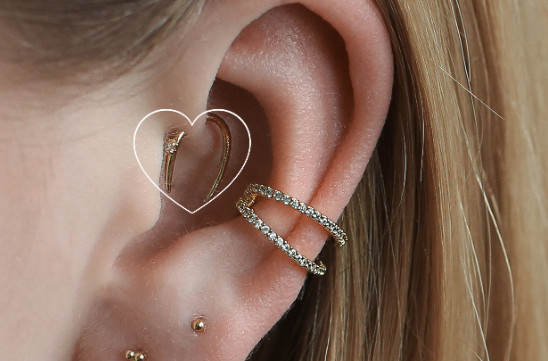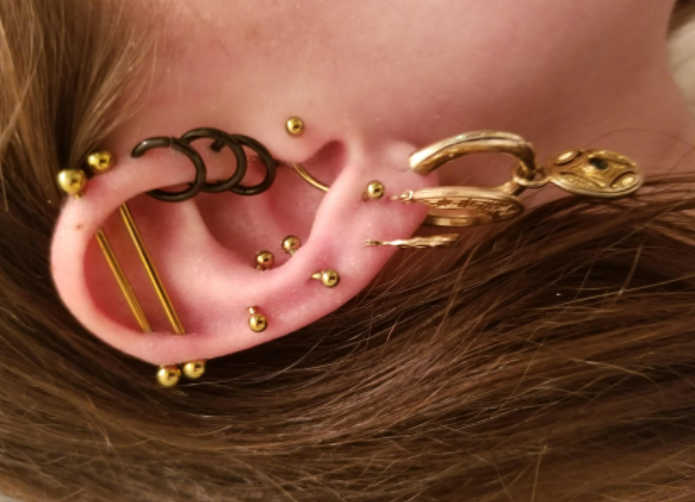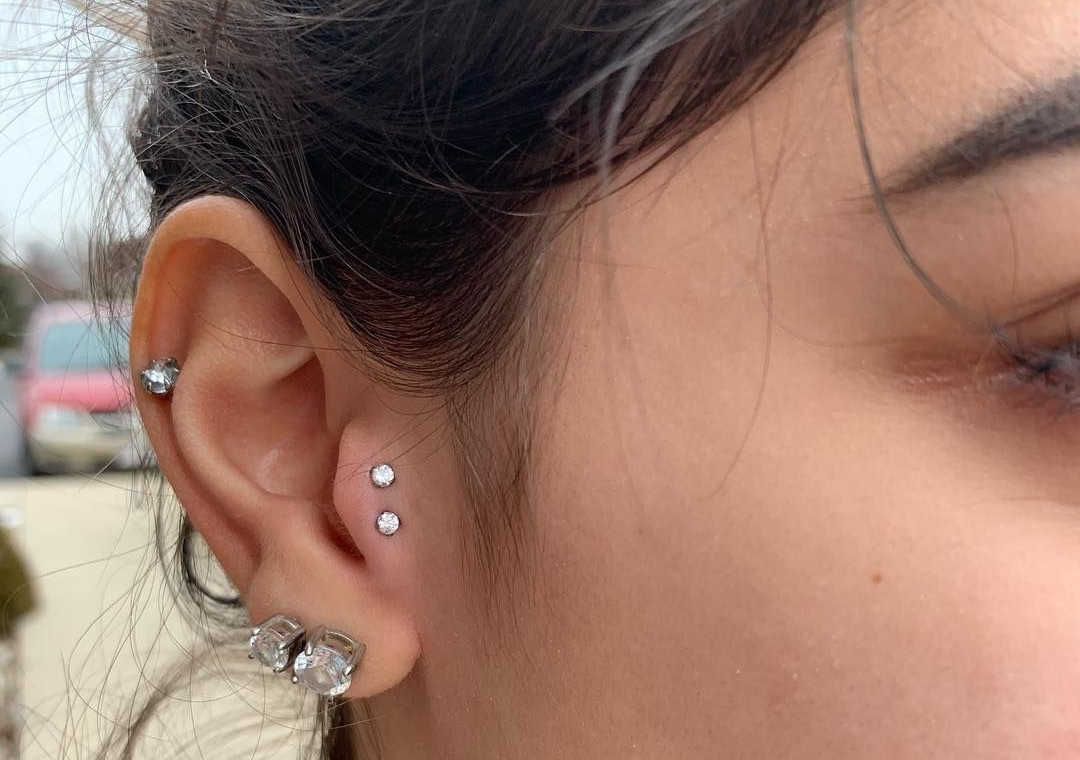It’s easy to think that turning any color from jewelry means something’s wrong. After all, what kind of metal could the jeweler be using that colors your skin? The good news is that there aren’t select chemicals or mysterious metals involved. The answer all comes down to chemistry.
All metals react to different elements. And some of them tarnish when they touch lotions, sweat, or sometimes even your skin. As the jewelry tarnishes, that coloring can rub off. Just like your fingers would look dirty if you rubbed an old penny between them for a while, the color is only tarnished that sticks to your hand.
The color that it leaves depends on the type of metal. Most metals have a dark tarnish that can leave dark gray or even black marks. But copper has a green tarnish—think of the Statue of Liberty—and leaves a green mark instead.

Why is My Jewelry Turning My Skin Green?
Most likely, your skin turned green from wearing copper jewelry. However, there are a variety of jewelry metals that turn your skin green. It’s essentially an oxidation process that occurs when you combine certain jewelry metals with skin. Often, costume jewelry predominantly made from copper leads to skin discoloration. It’s important to remember that skin discoloration from jewelry is not the same as a skin reaction or allergic reaction.
In fact, getting green skin from certain metals is a common reaction and does not hurt or harm your skin. If your skin is itchy or red, then you’re dealing with an adverse allergic reaction to the metal, rather than a chemical reaction.
We’ve talked about copper, but is it the only jewelry metal that turns skin green? Not quite. Many alloyed metals can cause skin discoloration, especially when mixed with perspiration and skin oils.
Is it bad if jewelry turns my fingers green?
The good news about these little marks is that they’re entirely harmless. The discoloration is just skin deep, like a dirt smudge. After a few hours, it will wear off. You can also wash your hands in warm water and soap to wash away some of the residues.
Even though it’s not harmful, it’s still not pretty! So how can we avoid it?
How to Remove Stains from Your Green Fingers?
Try waterproof eye makeup remover
Dampen a cotton ball with waterproof eye makeup remover, which you can buy at your local beauty supply store. Rub the cotton ball back and forth over the stained area of your finger, paying particular attention to the areas of webbing between your fingers where staining can concentrate.
- This method is very gentle and best for small areas of staining.
- You can leave the makeup remover on your skin, there is no need to wash your hands unless desired.

Use a cotton ball with rubbing alcohol
Dampen a cotton ball with everyday rubbing alcohol from your local drug store. Rub the cotton ball around the area of staining, taking care to avoid any broken skin. While a little redness is normal in reaction to alcohol, stop if you feel any irritation developing.
- Wash your hands with tap water and soap after using the rubbing alcohol.
- Alcohol can dry out your skin, so apply hand lotion when you’re finished to moisturize.

Use non-acetone nail polish remover
If your staining is extreme, dampen a cotton ball with non-acetone nail polish remover. Wipe the area of staining with the cotton ball, applying gentle pressure. When the stain is removed, wash your hands thoroughly with soap and water and moisturize.
- Do not apply nail polish remover on broken or irritated skin.
- As nail polish remover is very abrasive, don’t this method more than once a week.

Which types of jewelry turn your fingers green?
The “green finger” effect is a perfectly normal (if inconvenient) reaction for many metals. It happens most frequently with cheaper jewelry but not for the reasons you might think. It doesn’t have anything to do with dangerous metals or additives.
The single most likely reason a ring has left a mark on your hand is a high copper or silver content. Those two metals can tarnish quickly, and they’re the most common culprits.
Silver is, of course, a precious metal you’ll find in fine jewelry, and there’s plenty of beautiful copper jewelry.
So why is cheaper jewelry more likely to leave a green ring? Because of how jewelers mix gold.
Nearly all the gold you buy today is mixed with other metals. Pure 24-karat gold is too soft for durable jewelry. Jewelers combine it with other metals, most commonly copper, to strengthen it.
But in cheap jewelry, there’s often more copper than gold. Ten-karat gold, for example, is only 10/24ths gold, or 42% pure.
(At Blush and Bar, we use 18-karat gold—the standard for premium jewelry.)
And sometimes, a “gold-plated” ring will use copper as the base metal. Once that thin layer of gold wears off in a few months or years, the copper will directly touch your skin.
How can I make sure jewelry doesn’t turn my fingers green?
There are a few jewelry tips to avoid discoloring your hands.
First, you’ll want to keep your hands dry. If you put on lotion or wash your hands, make sure they’re very dry before putting on jewelry.
Water (and the chemicals in lotions and soaps) can cause your jewelry to tarnish faster.
You should also take your jewelry off when swimming, bathing, washing your hands, or working out.
Another tip is to paint the inside of your rings with clear nail polish. This will provide a thin but effective layer of protection so the metal won’t be in contact with your skin.
But the most important tip? Buy the right kind of jewelry.
How to purchase jewelry correctly?
There are a few ways to avoid jewelry turning your fingers green or black.
First, notice which pieces cause that reaction. Most people aren’t affected, but some see reactions with products they use daily or even their skin’s natural pH level.
If you notice a problem with a specific metal—usually copper or silver—avoid wearing that metal type.
If you’re not sure, a good option is to avoid jewelry with high copper content. At CHURINGA, we make our vermeil rings with 18K karat gold, which means less copper.
Vermeil is two and a half times as thick as gold plating, so your pieces will safely last for years. And instead of a cheap copper metal inside, we use sterling silver, one of the most hypoallergenic options.
Can a Rhodium plating solve the jewelry turn green?
Well maybe, but there are drawbacks to consider too. Artisanal handmade sterling silver rings are rarely rhodium plated. But most commercial mass-produced sterling silver jewelry available in malls is rhodium plated these days. It’s very a thin layer of expensive metal, Rhodium, coated over a base substrate, in this case, sterling silver. It prevents silver jewelry from tarnishing, which is why it’s so commonly used in these retail settings. Can you imagine how much time a salesperson would have to spend polishing all that sterling silver jewelry sitting in their showcases to keep it shiny white looking? Rhodium is also a quite hard metal and can give jewelry made from softer sterling silver an initial advantage when it comes to scratch resistance. It also gives it a similar look like plated white gold jewelry at a lower price.
So sounds great, right? Well not so fast. That thin layer of rhodium will wear off over time. It may be a great solution for necklaces or earrings that don’t get the rubbing action a ring gets. But on rings, especially those worn daily like engagement or wedding rings, that Rhodium layer can come off quite fast. How fast depends on the layer thickness and each person’s wear and body chemistry. Some people can strip a plating within days or weeks, for others it may hold for a couple of months or even a year or two. But it will eventually always wear off. And when it does come off, it won’t look pretty as it wears unevenly. Rhodium plating does not age well. It may look blotchy and get scratches exposing the different material underneath in some parts more than in others. That material underneath is not necessarily nicely white polished sterling silver. The silver below may have a different texture than the plated surface and tarnishes.
The layer thickness of the plating may vary widely from one manufacture to another. Some just do a flash plating job that won’t last more than a few weeks at all. Often rhodium plating isn’t directly done over sterling silver but plated with a layer of nickel first. When the rhodium wears off, your skin gets exposed to nickel, which causes skin allergies with nasty rashes for quite a lot of people. So you may have avoided your harmless green stain issue and got a nasty red rash instead sometime later. A Rhodium allergy is unusual, but possible too.
Sure you can try to get your ring re-plated as soon as it starts wearing off. But that process isn’t cheap and you will pay quickly more in these re-plating jobs than your sterling silver ring cost you initially. It’s also a pain to do any repair work on plated rings as the plating first needs to get stripped before it gets sized or repaired, adding cost to the process. Refinishing a plated ring is also not as easy as repolishing an un-plated sterling silver ring. The normal polishing action on a polishing wheel would just strip the thin layer of rhodium off.
How You Can Prevent Jewelry Turn Your Finger Green?
Of course, “green finger” isn’t necessarily very attractive, and most of us would prefer to avoid it if possible. As jewelry lovers ourselves, we’ve picked up a few tricks on how to keep our own rings from turning our fingers green. Here are our top three favorite (and easy) ways to prevent “green finger”:
- Stay dry: Take care not to wear your rings when you’re doing things like showering, putting on lotion, or washing your hands as wetness increases the chance of oxidation. But don’t worry — you can still rock your jewelry on your next beach trip. Just make sure you take it off before you jump in the water for a swim.
- Avoid the cheap stuff: Jewelry made with low-quality materials (aka nickel) can cause irritation. Similarly, fast fashion jewelry that has a very thin layer of plating can cause tarnishing more quickly. Be sure to do your research into the metals that are being used to make the pieces you’re interested in before purchasing.
- Know your skin: It may take some trial and error, but once you know which metals your skin reacts to, you will know which types of jewelry to avoid!
Our production process at Gemandi allows for a prolonged period of time before tarnishing may set in for your jewelry. The nickel-free base of each piece is dipped three times in 14-karat gold, resulting in plating that is five times thicker than most other plated jewelry out there. To keep your pieces tarnish-free for even longer, you can check out our best practices for proper jewelry care to ensure that your pieces stay looking shiny and new long after they’ve made it into your daily rotation.
What can you do if you experience a green stain from your newly acquired nicely hand made ring you love so much?
- check if it’s too tight and traps sweat and moisture underneath, if so ask the maker if they can stretch it slightly for you to provide a better fit
- clean your ring and skin well and keep both dry, don’t wear it when being exposed to water like showering, hand washing, swimming etc. Remove rings at night to give your skin a chance to breath.
- change your diet so your skin is less acid (probably note everyone’s first approach)
- clean the inside of the ring as often as possible (daily) with polishing cloth. After about a week or two, the reaction should stop occurring.
- try soaking your rings in a mixture of household ammonia and water (50/50) for a day or two. The ammonia solution will turn blue as it forms a copper ammonia ion. This will not hurt the silver. After that, your rings will not turn your skin green because the copper has been removed from the surface of the sterling. Be careful if you have any stones set in your rings. Some stones should not be soaked in ammonia.
- consider if Rhodium plating may be worth it for you with all the maintenance issues it may have
- apply a protective shield like clear nail polish to the inside of your ring. It will wear off over time and has to be redone.
- if all does not help consider remaking the ring in a different metal. Platinum, palladium and 18k gold are usually safe options but come at a higher price. Or use some of the new silver alloys like Argentium, Continuum, deox-silver, palladium sterling or platinum sterling which are only slightly more expensive than traditional sterling silver.
Tips To Prevent Jewelry From Turning Your Skin Green
- Minimize your copper jewelry, or only wear them sparingly and for short periods of time.
- Get your jewelry rhodium-plated, which will put a layer of protection between the jewelry and your skin and also increase the lifespan of your jewelry.
- Don’t wear jewelry that turns skin green on hot days, because perspiration is the main reason why jewelry metals oxidize against your skin and lead to discoloration.
- Clean your jewelry regularly to remove dirt, liquids, lotions, or soap particles that might cling to the jewelry and lead to oxidation against the skin.
- Don’t swim with your jewelry on as chlorine and copper produce an intense reaction against your skin.
- Remove your jewelry when cleaning. Standard cleaning supplies also contain chlorine which can cause discoloration when wearing gold jewelry.
- Intermittently remove jewelry items to alleviate skin discoloration and give your skin a chance to breathe.
As you can see, many metals and alloys cause skin discoloration when combined with the elements. However, skin discoloration is not permanent or harmful. Following these steps will help you minimize skin discoloration and get back to enjoying your beautiful jewelry items.
Ten articles before and after
White Bronze Vs Sterling Silver Jewelry Which one is better?
Argentium Silver Vs Sterling Silver Jewelry Which one is Better?
Silver Plated Vs Sterling Silver Jewelry Which is Better?
What does the Black butterfly symbolize?
The Symbolism Of Different Butterfly Cultures
How Can I Tell If A Necklace Is a Real Silver?




